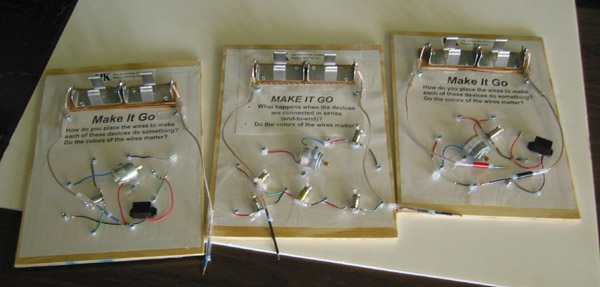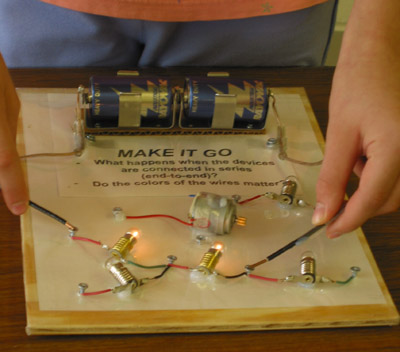
Instructions For:
Make It Go Boards
These circuit boards are a way to explore electricity. Students can connect and complete circuits to produce both light and sound energy from the electrical energy stored in the batteries.
There are three (3) boards included in each Zoo kit. Two of them are nearly identical, including a motor, light bulb, buzzer, and light emitting diode (LED). Another board includes only light bulbs and a motor, wired in several series combinations. This arrangement allows exploration of various wiring possibilities using different combinations of circuit elements.

While not capable of producing a harmful level of electric current, caution should be exercised when using the Make it Go boards.
Questions for Students / Items of Interest:
Q1) Why are two connections needed to "Make It Go"?
In order for current to travel through the wires, a complete, closed-loop circuit is necessary. The two lead wires bridge two gaps in the circuit, by connecting the positive and negative battery terminals with circuit element wires.
Q2) What happens to the motor, LED, and buzzer when the lead wires are reversed?
This changes the direction of the electrical current. The motor will change its direction of rotation, the LED will change colors (this is a special, two-element LED,) and the buzzer won’t work at all if the current is being driven in the wrong direction. The light bulb, which produces light and heat energy from electrical resistance, works identically regardless of polarity.
Note to teachers:
An interesting phenomenon is observed when a motor and light bulb are connected in series, as on one of the Make It Go boards included in the Petting Zoo. As the circuit is connected, the bulb lights and the motor begins to turn, as expected, but as the motor reaches its maximum rate of rotation, the bulb no longer produces any light. Indeed, current has stopped flowing through the circuit, as indicated by the dim light bulb. The motor, once up to speed, requires little power to continue its motion, and automatically regulates the current in the circuit by producing a "back EMF" (EMF, short for electromotive force, is physics-speak for voltage) that cancels out the voltage applied by the battery (most batteries are 1.5 volts, you can check their metal casings to see this). With no net voltage to create a current, the light bulb goes out. When the circuit is broken, the motor slows down and stops, and as this happens the bulb again lights up, as energy stored in the motion of the motor is released as electricity.
Copyright 2004 Straley/Pinney - The University of Kentucky Physics Petting Zoo